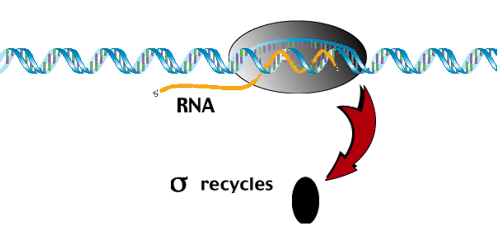|
|
|
Biology 335 - Molecular Genetics
Transcription I
|
|
|
|
| The second component of the transcription process is the DNA-dependant RNA polymerase enzyme complex. In E. coli, the RNA polymerase complex is relatively simple - consisting of two copies of the alpha subunit, one of the beta subunit and one of the beta-prime subunit. This is the only RNA polymerase in E. coli and is responsible for the transcription of all the bacterium's RNAs.
In contrast, eukaryotes have three distinct RNA polymerases - each responsible for the transcription of a specific class of RNAs.
|
|
|
RNA polymerase I - transcribes rRNAs.
RNA polymerase II - transcribes all mRNAs
RNA polymerase III - transcribes the small functional RNAs - tRNAs & 5S rRNAs.
|
|
| We divide the process of transcription into three stages:
Initiation, Elongation and Termination
|
|
| Initiation:
The initiation of transcription by RNA polymerase involves the binding of the polymerase to specific template sequences called the promoter.
The structure of the promoter was originally revealed by comparing the DNA sequences upstream of many different transcription initiation sites. Two blocks of highly conserved sequence were identified centered 10 bp and 35 bp upstream of position +1 - the first nucleotide of the transcript.
These two 'promoter' sequences were subsequently shown to interact directly with RNA polymerase during the initiation phase.
|
|
|
 |
|
|
|
Basic Features of the Promoter
|
|
| While the alpha (2) beta - beta-prime complex is the active polymerase during the elongation phase, it is unable to recognize the promoter sequence on its own. To initiate, the polymerase must interact with an initiation factor called sigma. This polymerase complex is then capable of recognizing and binding to the promoter as shown below
|
|
|
 |
|
|
|
The Closed Complex
|
|
| The closed complex undergoes a conformational shift which stresses the double helix promoting its unwinding and eventually producing the Open Complex which is poised for RNA polymerization.
|
|
|
 |
|
|
|
The Open Complex
|
|
|
The open complex initiates synthesis, which moves us to the elongation phase.
Sigma dissociates from the core enzyme and recycles for continued initiation of transcription.
|
|
|
|
 |
|
|
 |
|
|
go to
Transcription II
|
|
|
|
|
|
|
|
|
|
|
|
|
|



